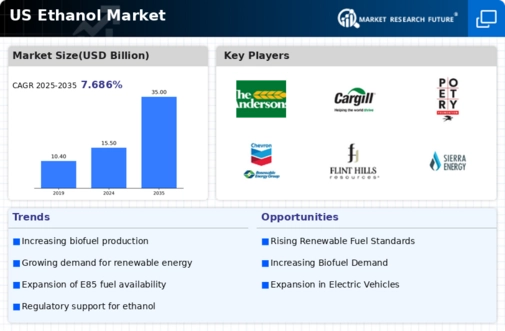The ethanol market in the United States is characterized by a competitive landscape that is increasingly shaped by innovation, sustainability initiatives, and strategic partnerships. Key players such as POET LLC (US), Archer Daniels Midland Company (US), and Valero Energy Corporation (US) are at the forefront of this dynamic environment. POET LLC (US) has positioned itself as a leader in biofuel production, focusing on advanced technologies to enhance efficiency and reduce emissions. Meanwhile, Archer Daniels Midland Company (US) has been actively pursuing mergers and acquisitions to expand its operational footprint and diversify its product offerings, thereby strengthening its market presence. Valero Energy Corporation (US) has adopted a strategy centered on integrating renewable fuels into its existing operations, which not only enhances its sustainability profile but also aligns with the growing consumer demand for greener energy solutions.
The business tactics employed by these companies reflect a concerted effort to optimize supply chains and localize manufacturing processes. The market structure appears moderately fragmented, with several key players exerting considerable influence over pricing and production capabilities. This competitive environment is further complicated by the presence of smaller firms that are increasingly innovating to capture niche segments of the market. The collective actions of these major companies suggest a trend towards consolidation, as they seek to leverage economies of scale and enhance operational efficiencies.
In November 2025, POET LLC (US) announced a groundbreaking partnership with a leading agricultural technology firm to develop next-generation biofuels. This collaboration is expected to enhance POET's production capabilities and reduce the carbon footprint of its operations, thereby reinforcing its commitment to sustainability. The strategic importance of this partnership lies in its potential to position POET as a pioneer in the development of innovative biofuel solutions, which could significantly influence market dynamics.
In October 2025, Archer Daniels Midland Company (US) completed the acquisition of a regional ethanol producer, which is anticipated to bolster its production capacity and expand its market reach. This acquisition not only enhances ADM's operational scale but also allows for greater integration of sustainable practices across its supply chain. The strategic significance of this move is underscored by the increasing regulatory pressures for cleaner energy sources, positioning ADM favorably in a transitioning market.
In September 2025, Valero Energy Corporation (US) launched a new initiative aimed at increasing the use of renewable diesel in its refineries. This initiative is part of Valero's broader strategy to diversify its fuel offerings and meet the rising demand for low-carbon alternatives. The importance of this initiative cannot be overstated, as it aligns with the growing trend towards sustainability and positions Valero as a key player in the renewable energy sector.
As of December 2025, the competitive trends within the ethanol market are increasingly defined by digitalization, sustainability, and the integration of artificial intelligence in production processes. Strategic alliances are becoming more prevalent, as companies recognize the need to collaborate in order to innovate and meet evolving consumer demands. Looking ahead, it is likely that competitive differentiation will shift from traditional price-based strategies to a focus on innovation, technological advancements, and supply chain reliability, reflecting the broader trends in the energy sector.



















Leave a Comment